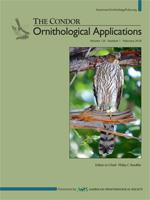We used a broad-scale sampling design to investigate spatial patterns in occupancy and breeding success of territorial pairs of Golden Eagles (Aquila chrysaetos) in the Diablo Range, California, USA, during a period of exceptional drought (2014–2016). We surveyed 138 randomly selected sample sites over 4 occasions each year and identified 199 pairs of eagles, 100 of which were detected in focal sample sites. We then used dynamic multistate modeling to identify relationships between site occupancy and reproduction of Golden Eagles relative to spatial variability in landscape composition and drought conditions. We observed little variability among years in site occupancy (3-yr mean = 0.74), but the estimated annual probability of successful reproduction was relatively low during the study period and declined from 0.39 (± 0.08 SE) to 0.18 (± 0.07 SE). Probabilities of site occupancy and reproduction were substantially greater at sample sites that were occupied by successful breeders in the previous year, indicating the presence of sites that were consistently used by successfully reproducing eagles. We found strong evidence for nonrandom spatial distribution in both occupancy and reproduction: Sites with the greatest potential for occupancy were characterized by rugged terrain conditions with intermediate amounts of grassland interspersed with patches of oak woodland and coniferous forest, whereas successful reproduction was most strongly associated with the amount of precipitation that a site received during the nesting period. Our findings highlight the contribution of consistently occupied and productive breeding sites to overall productivity of the local breeding population, and show that both occupancy and reproduction at these sites were maintained even during a period of exceptional drought. Our approach to quantifying and mapping site quality should be especially useful for the spatial prioritization of compensation measures intended to help offset the impacts of increasing human land use and development on Golden Eagles and their habitats.
How to translate text using browser tools
3 January 2018
Spatial patterns in occupancy and reproduction of Golden Eagles during drought: Prospects for conservation in changing environments
J. David Wiens,
Patrick S. Kolar,
W. Grainger Hunt,
Teresa Hunt,
Mark R. Fuller,
Douglas A. Bell
ACCESS THE FULL ARTICLE

The Condor
Vol. 120 • No. 1
February 2018
Vol. 120 • No. 1
February 2018
Aquila chrysaetos
drought
golden eagle
occupancy
reproduction
Wind energy




